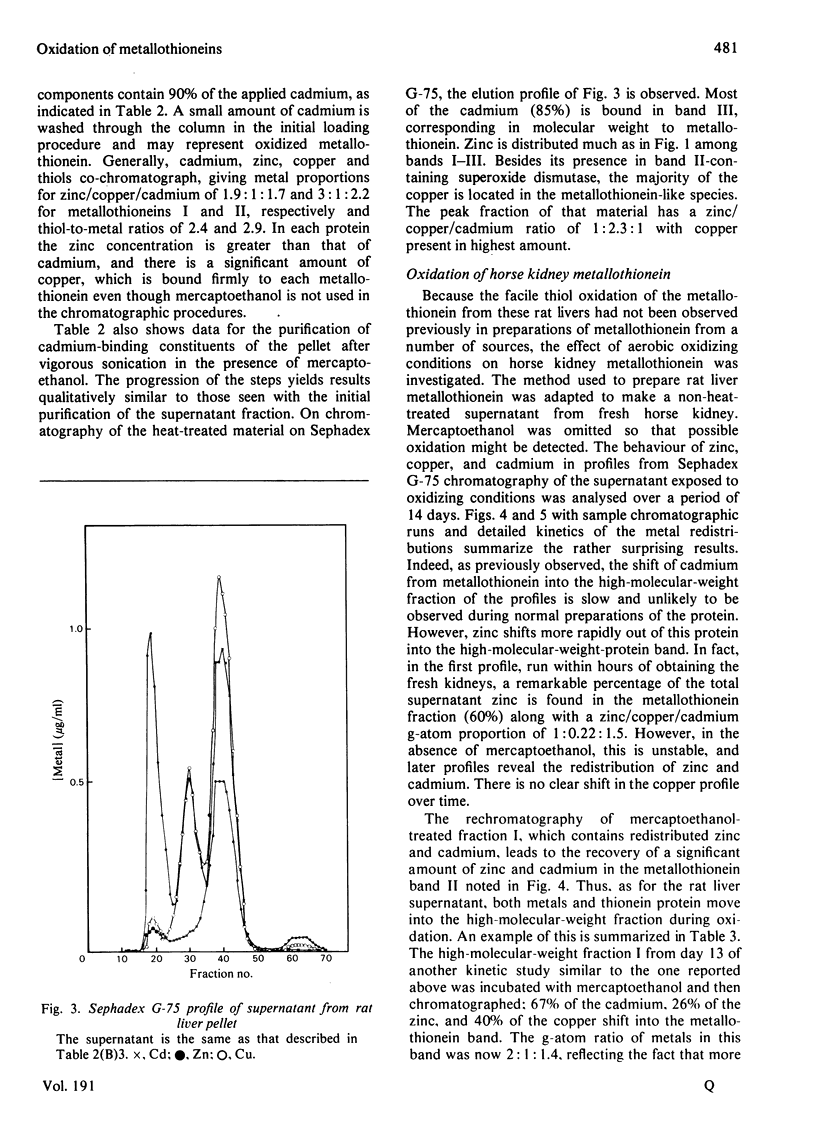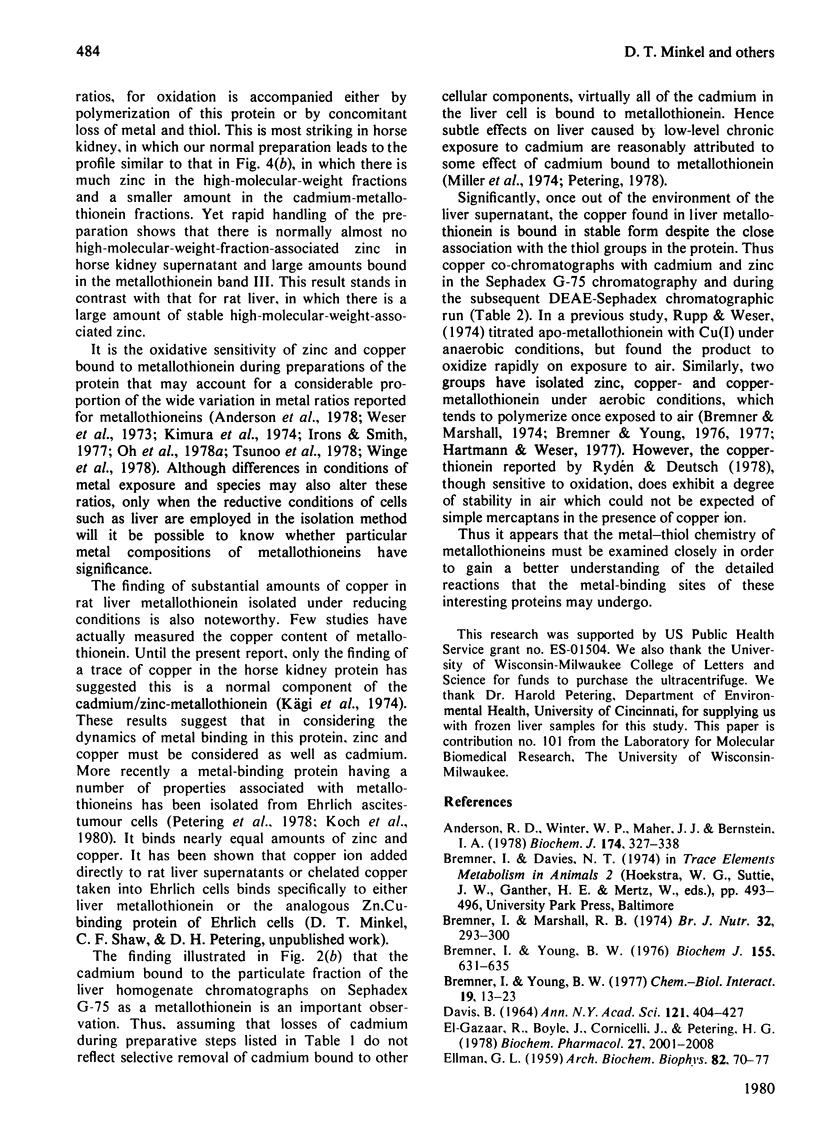Abstract
It is demonstrated that the distribution of metals among the Sephadex G-75 fractions of rat liver and horse kidney supernatant is altered by exposure to oxidizing conditions. In particular, the metals bound to metallothionein are displaced into high-molecular-weight fractions and, to a lesser extent, into the low-molecular-weight forms, under aerobic conditions. In this process, metallothionein zinc is much more labile than cadmium. An appreciable proportion of the thionein is also found in the high-molecular-weight fractions and can be recovered along with the metals by treatment with mercaptoethanol. This result shows that the distributions obtained aerobically with large cadmium content in the high-molecular-weight fractions are an artefact due to metallothionein oxidation and suggests that 'spillage' of metals such as cadmium may be due in large part to oxidative processes rather than saturation effects. Evidence is presented that disulphide-bond formation occurs as thionein becomes bound in the high-molecular-weight region and that chemical reduction is necessary to restore its normal elution behaviour. Mercaptoethanol added to the homogenates maintains the reducing conditions normally found in the cellular milieu and prevents the oxidation of the metallothionein redistribution of the metals during isolation. Under these conditions the rat liver metallothionein isolated from animals exposed to chronic low concentrations of cadmium in drinking water contains appreciable quantities of copper as well as zinc and contains much of the zinc that is present in horse kidney supernatants. Metallothionein can also be extracted from a 40 000g pellet after sonication of the pellet. Thus careful analytical studies of the sites of cadmium deposition in rat liver indicate that greater than 95% is bound to metallothionein.
Full text
PDF










Selected References
These references are in PubMed. This may not be the complete list of references from this article.
- Andersen R. D., Winter W. P., Maher J. J., Bernstein I. A. Turnover of metallothioneins in rat liver. Biochem J. 1978 Jul 15;174(1):327–338. doi: 10.1042/bj1740327. [DOI] [PMC free article] [PubMed] [Google Scholar]
- Bremner I., Marshall R. B. Hepatic copper- and zinc-binding proteins in ruminants. 2. Relationship between Cu and Zn concentrations and the occurrence of a metallothionein-like fraction. Br J Nutr. 1974 Sep;32(2):293–300. doi: 10.1079/bjn19740082. [DOI] [PubMed] [Google Scholar]
- Bremner I., Young B. W. Copper thionein in the kidneys of copper-poisoned sheep. Chem Biol Interact. 1977 Oct;19(1):13–23. doi: 10.1016/0009-2797(77)90039-4. [DOI] [PubMed] [Google Scholar]
- Bremner I., Young B. W. Isolation of (copper, zinc-) thioneins from pig liver. Biochem J. 1976 Jun 1;155(3):631–635. doi: 10.1042/bj1550631. [DOI] [PMC free article] [PubMed] [Google Scholar]
- DAVIS B. J. DISC ELECTROPHORESIS. II. METHOD AND APPLICATION TO HUMAN SERUM PROTEINS. Ann N Y Acad Sci. 1964 Dec 28;121:404–427. doi: 10.1111/j.1749-6632.1964.tb14213.x. [DOI] [PubMed] [Google Scholar]
- ELLMAN G. L. Tissue sulfhydryl groups. Arch Biochem Biophys. 1959 May;82(1):70–77. doi: 10.1016/0003-9861(59)90090-6. [DOI] [PubMed] [Google Scholar]
- El-Gazzar R., Boyle J., Cornicelli J., Petering H. G. Effect of cadmium ingestion on cadmium and zinc profile in male and female rat liver cytosol. Biochem Pharmacol. 1978;27(16):2001–2008. doi: 10.1016/0006-2952(78)90058-8. [DOI] [PubMed] [Google Scholar]
- Fridovich I. Superoxide dismutases. Adv Enzymol Relat Areas Mol Biol. 1974;41(0):35–97. doi: 10.1002/9780470122860.ch2. [DOI] [PubMed] [Google Scholar]
- Fridovich I. Superoxide dismutases. Annu Rev Biochem. 1975;44:147–159. doi: 10.1146/annurev.bi.44.070175.001051. [DOI] [PubMed] [Google Scholar]
- Hartmann H. J., Weser U. Copper-thionein from fetal bovine liver. Biochim Biophys Acta. 1977 Mar 28;491(1):211–222. doi: 10.1016/0005-2795(77)90057-5. [DOI] [PubMed] [Google Scholar]
- Irons R. D., Smith J. C. Partial saturation of rat liver Cd-binding proteins by Cd2+ in vivo. Arch Environ Contam Toxicol. 1977;6(2-3):193–202. doi: 10.1007/BF02097760. [DOI] [PubMed] [Google Scholar]
- KAGI J. H., VALEE B. L. Metallothionein: a cadmium- and zinc-containing protein from equine renal cortex. J Biol Chem. 1960 Dec;235:3460–3465. [PubMed] [Google Scholar]
- KAGI J. H., VALLEE B. L. Metallothionein: a cadmium and zinc-containign protein from equine renal cortex. II. Physico-chemical properties. J Biol Chem. 1961 Sep;236:2435–2442. [PubMed] [Google Scholar]
- Kimura M., Otaki N., Yoshiki S., Suzuki M., Horiuchi N. The isolation of metallothionein and its protective role in cadmium poisoning. Arch Biochem Biophys. 1974 Nov;165(1):340–348. doi: 10.1016/0003-9861(74)90172-6. [DOI] [PubMed] [Google Scholar]
- Kägi J. H., Himmelhoch S. R., Whanger P. D., Bethune J. L., Vallee B. L. Equine hepatic and renal metallothioneins. Purification, molecular weight, amino acid composition, and metal content. J Biol Chem. 1974 Jun 10;249(11):3537–3542. [PubMed] [Google Scholar]
- Miller M. L., Murthy L., Basom C. R., Petering H. G. Alterations in hepatocytes after manipulation of the diet: copper, zinc and cadmium interactions. Am J Anat. 1974 Sep;141(1):23–40. doi: 10.1002/aja.1001410103. [DOI] [PubMed] [Google Scholar]
- Nordberg G. F., Nordberg M., Piscator M., Vesterberg O. Separation of two forms of rabbit metallothionein by isoelectric focusing. Biochem J. 1972 Feb;126(3):491–498. doi: 10.1042/bj1260491. [DOI] [PMC free article] [PubMed] [Google Scholar]
- Oh S. H., Deagen J. T., Whanger P. D., Weswig P. H. Biological function of metallothionein-IV. Biosynthesis and degradation of liver and kidney metallothionein in rats fed diets containing zinc or cadmium. Bioinorg Chem. 1978;8(3):245–254. doi: 10.1016/s0006-3061(00)80200-8. [DOI] [PubMed] [Google Scholar]
- Oh S. H., Deagen J. T., Whanger P. D., Weswig P. H. Biological function of metallothionein. V. Its induction in rats by various stresses. Am J Physiol. 1978 Mar;234(3):E282–E285. doi: 10.1152/ajpendo.1978.234.3.E282. [DOI] [PubMed] [Google Scholar]
- Petering H. G. Some observations on the interaction of zinc, copper, and iron metabolism in lead and cadmium toxicity. Environ Health Perspect. 1978 Aug;25:141–145. doi: 10.1289/ehp.7825141. [DOI] [PMC free article] [PubMed] [Google Scholar]
- Probst G. S., Bousquet W. F., Miya T. S. Kinetics of cadmium-induced hepatic and renal metallothionein synthesis in the mouse. Toxicol Appl Pharmacol. 1977 Jan;39(1):51–60. doi: 10.1016/0041-008x(77)90176-4. [DOI] [PubMed] [Google Scholar]
- Richards M. P., Cousins R. J. Metallothionein and its relationship to the metabolism of dietary zinc in rats. J Nutr. 1976 Nov;106(11):1591–1599. doi: 10.1093/jn/106.11.1591. [DOI] [PubMed] [Google Scholar]
- Rupp H., Weser U. Conversion of metallothionein into Cu-thionein, the possible low molecular weight form of neonatal hepatic mitochondrocuprein. FEBS Lett. 1974 Aug 30;44(3):293–297. doi: 10.1016/0014-5793(74)81161-0. [DOI] [PubMed] [Google Scholar]
- Rydén L., Deutsch H. F. Preparation and properties of the major copper-binding component in human fetal liver. Its identification as metallothionein. J Biol Chem. 1978 Jan 25;253(2):519–524. [PubMed] [Google Scholar]
- Shaikh Z. A., Smith J. C. The mechanisms of hepatic and renal metallothionein biosynthesis in cadmium-exposed rats. Chem Biol Interact. 1977 Nov;19(2):161–171. doi: 10.1016/0009-2797(77)90028-x. [DOI] [PubMed] [Google Scholar]
- Sobocinski P. Z., Canterbury W. J., Jr, Mapes C. A., Dinterman R. E. Involvement of hepatic metallothioneins in hypozincemia associated with bacterial infection. Am J Physiol. 1978 Apr;234(4):E399–E406. doi: 10.1152/ajpendo.1978.234.4.E399. [DOI] [PubMed] [Google Scholar]
- Tsunoo H., Kino K., Nakajima H., Hata A., Huang I. Y., Yoshida A. Mouse liver metallothioneins. Purification, molecular weight, amino acid composition, and metal content. J Biol Chem. 1978 Jun 25;253(12):4172–4174. [PubMed] [Google Scholar]
- Webb M. Binding of cadmium ions by rat liver and kidney. Biochem Pharmacol. 1972 Oct 15;21(20):2751–2765. doi: 10.1016/0006-2952(72)90023-8. [DOI] [PubMed] [Google Scholar]
- Weser U., Rupp H., Donay F., Linnemann F., Voelter W., Voetsch W., Jung G. Characterization of Cd, Zn-thionein (metallothionein) isolated from rat and chicken liver. Eur J Biochem. 1973 Nov 1;39(1):127–140. doi: 10.1111/j.1432-1033.1973.tb03111.x. [DOI] [PubMed] [Google Scholar]
- Winge D. R., Premakumar R., Rajagopalan K. V. Metal-induced formation of metallothionein in rat liver. Arch Biochem Biophys. 1975 Sep;170(1):242–252. doi: 10.1016/0003-9861(75)90115-0. [DOI] [PubMed] [Google Scholar]
- Winge D. R., Premakumar R., Rajagopalan K. V. Studies on the zinc content of Cd-induced thionein. Arch Biochem Biophys. 1978 Jun;188(2):466–475. doi: 10.1016/s0003-9861(78)80031-9. [DOI] [PubMed] [Google Scholar]
- Winge D. R., Rajagopalan K. V. Purification and some properties of Cd-binding protein from rat liver. Arch Biochem Biophys. 1972 Dec;153(2):755–762. doi: 10.1016/0003-9861(72)90395-5. [DOI] [PubMed] [Google Scholar]


